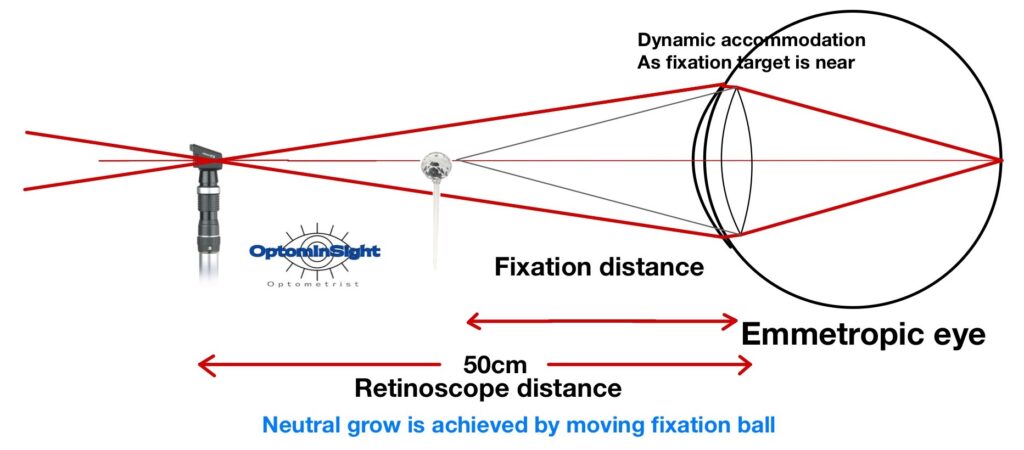Procedure of Bell retinoscopy
Bell retinoscopy procedure involves the use of a shiny steel ball, typically gold or silver in color, which is attached to a stick. The examiner holds the stick along the midline, at a certain distance from the patient. This technique derives its name from a small bell that used to hang on a string and served as a fixation target for the patient, which later was replaced by shiny steel ball. The retinoscope is positioned slightly farther away from the steel ball, approximately 50 cm away from the subject.
During the procedure, the subject is asked to wear his/her subjective refraction and is instructed to maintain fixation on the steel ball, which is positioned between the subject and the retinoscope. Retinoscopy is then performed while keeping the retinoscope in a static position. The goal is to achieve neutrality by manipulating the position of the steel ball.
If movement is observed in the same direction as the movement of the retinoscope, the fixation target (steel ball) is moved closer to the subject’s eye while the subject continues to fixate on it. Conversely, if movement is observed in the opposite direction, the fixation target is moved away from the subject.

The final result is determined by measuring the distance between the fixation target (steel ball) and the retinoscope from the patient’s eye. This measurement is taken in centimeters and then converted to diopters using the formula: 100 divided by the measured distance. For example, if the fixation target is placed at 40 cm, movement is observed at 40 cm, and the neutral point is found at 33 cm, the calculations would be as follows:
Distance of fixation target from patient in diopters: 100/33 = 3.0 D
Distance of retinoscope from patient in diopters: 100/50 = 2.0 D
Bell retinoscopy value: Distance of fixation target from patient in diopters – Distance of retinoscope from patient in diopters = 3.0 D – 2.0 D = +1.00 D
The interpretation of the Bell retinoscopy results is as follows
- The expected values for bell retinoscopy are inward shift at 42.5 to 35 cm and outward shift at 37.5 to 45 cm. inward shift mean when fixation target is moved towards patient and outward is when retinoscope is moved away from patient.
- Normal values for the additional lens power range from +0.25 DS to +0.75 D.
- High lag of accommodation is observed in conditions such as near esophoria, convergence excess, accommodation insufficiency, under corrected hyperopes or overcorrected myopes, and presbyopia.
- On the other hand, lead of accommodation is seen in near exophoria, convergence insufficiency, accommodative excess, spasm of accommodation, and under corrected myopes or overcorrected hyperopes.
Lecturer (Nethradhama School of Optometry)
Moptom

